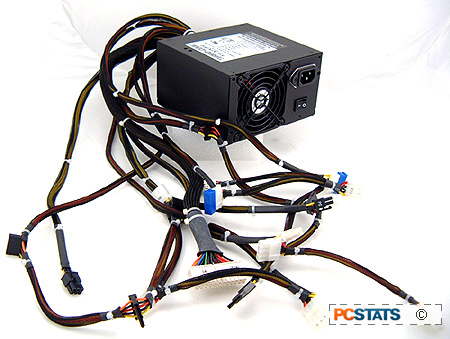 Power Jitter
Observations Power Jitter
Observations |
|
Voltage jitter is read by
accessing the power options displayed in the motherboard BIOS, with the system
obviously in an unloaded state. All voltages were read from the Motherboard BIOS
of a
DFI LANParty NF4
SLI/DR .
|
PC Power and Cooling Turbo-Cool 510
SLI |
| Listed Voltages |
Lower Voltage |
Upper Voltage |
Jitter |
| +3.3V |
3.25V |
3.27v |
0.02v |
| +5.0V |
4.99v |
5.02v |
0.03v |
| +12V |
12.02V |
12.09V |
0.07v |
| -12V |
-12.12V |
-12.12V |
0.00v |
| -5.0V |
-5.01v |
-5.01v |
0.00v |
| +5.0Vsb |
5.05v |
5.05v |
0.00v |
In the voltage jitter observations, the Turbo-Cool 510 Express/SLI
showed extremely steady voltages. The 0.07 jitter from the +12V rail was a
little larger than we'd normally like to see, but since the voltage numbers
are so accurate to begin with, this is pretty much irrelevant.
Note the rock steady +5V
rail.
When looking at the Seasonic Power Supply test results we see two values, wattage
and volt-amps. Since it might not be clear what they measure, here's a brief
overview.
The volt-amp (VA) value is how much real
power is being consumed by the power supply being tested to provide the wattage
(W) value. The higher the VA value is, the more electricity is
being used by the power supply. Because no electrical device is 100%
efficient, there will always be some loss when converting AC to DC. The
closer the volt-amps and wattage figures are to each other, the more efficient a
power supply is. This is called the Power Factor: wattage / volt-amps =
PF.
Since we're testing with a 120W dummy load, the
load on the power supply (W) should be as close to this figure as
possible. Anything above this load in apparent power describes the overhead and
wasted energy (given off as heat) for the particular power supply being tested.
For the
unloaded tests, the Wattage and Volt-Amp figures should be as close as
possible to one another. The lower the figures are, the
less power is being used. For the % Efficiency values, 100% is the best,
and 50% or less is quite poor.
|
Seasonic Power Load
Tests |
| Power Supply |
Wattage |
Test Type |
Loaded |
Unloaded |
| Seasonic SuperTornado |
400 W
(A-PFC) |
Active Power |
177 W |
6 W |
| Apparent Power |
182 VA |
7 VA |
| Vantec iON2 |
350 W |
Active Power |
192 W |
10 W |
| Apparent Power |
277 VA |
21 VA |
| Antec TruePower 330 |
330 W |
Active Power |
195 W |
22 W |
| Apparent Power |
289 VA |
38 VA |
| Ultra X-Connect Green UV 500W |
500 W |
Active Power |
193W |
22 W |
| Apparent Power |
307 VA |
40 VA |
| AOpen Silent Power AO400-12AHN |
400 W |
Active Power |
179W |
9 W |
| Apparent Power |
275 VA |
18 VA |
| Seasonic S12-430 |
430 W
(A-PFC) |
Active Power |
179W |
6W |
| Apparent Power |
180VA |
9VA |
| PC Power and Cooling Turbo-Cool
510 Express/SLI
|
510 W
(A-PFC)
|
Active Power |
200 W
|
29 W
|
| Apparent Power
|
202 VA
|
32 VA |
As the only Active Power-Factor Correcting (A-PFC) power
supply in the test results besides the Seasonic SuperTornado and S12-430,
the PC Power and Cooling Turbo-Cool 510 Express/SLI turns in an excellent power efficiency from the point of view of power conversion.
Active PFC really does make a huge difference in the amount of
energy wasted by your computer, and consequently how much you end up paying
in power bills later on.
In terms of actual power consumption though, the Turbo-Cool 510 Express/SLI is
a bit of a hog. Its unloaded power consumption was 29W, and
loaded power consumption was slightly higher than the rest of the field as
well at 200W. It's not going to bankrupt you, but its worth noting that
this PSU is better turned off when you leave for summer vacation.
Stable as a rock, heavy on the power
 Once the heavyweight PC Power and Cooling Turbo-Cool 510 Express/SLI was pulled
out of its packaging, we were expecting good things from it and
it did not disappoint.
Once the heavyweight PC Power and Cooling Turbo-Cool 510 Express/SLI was pulled
out of its packaging, we were expecting good things from it and
it did not disappoint.
This power supply proved to be extremely
solid and accurate in terms of the voltage it delivered across its various
rails. As one of only four PSU's specifically approved by nVidia for
use with SLI videocard systems, you'd expect solid power performance and the
Turbo-Cool 510 Express/SLI delivers.
The PC Power and Cooling Turbo-Cool 510 Express/SLI is completely nondescript
in appearance, though its nicely wrapped cables and the 14AWG
duty AC power cable it ships with are both good indicators of the
build quality PC Power and Cooling has put into this unit.
In terms of power use, the Turbo-Cool 510 Express/SLI
takes a bit more for itself than most of the PSUs we've tested, especially when
not under load. In light of its Active-PFC inspired 99.0% power efficiency and excellent voltage
stability though, voltage regulating potentiometers for fine adjustments in overclocked settings,
and twin 6-pin SLI power cables, that one small disparity is
easily forgiven.
PC Power and Cooling offers a five year warranty on
the Turbo-Cool 510 Express/SLI. Considering that power
supplies are the most common cause of computer failure, this indicates a comforting degree of confidence in the product by the manufacturer.
At a price of $265CDN ($215 US) for the 510 Watt model,
the PC Power and Cooling Turbo-Cool 510 Express/SLI power supply is anything but cheap. For
hardcore overclockers and SLI enthusiasts, or anyone investing serious amounts
of money into their computer hardware, the price of the
Turbo-Cool 510 is well worth it for the performance delivered.

Find out about this and many other reviews by
joining the Weekly PCstats.com
Newsletter today! Catch all of PCstats
latest hardware reviews right
here.
Related Articles
Here are a few other articles that you might enjoy
as well...
1. Antec TruePower 330W Power Supply Review
2. PC Power & Cooling Turbo-Cool 510-PFC Power Supply
3. Seasonic Super Tornado 400W Power Supply Review
4. Vantec iON2 350W Power Supply Review
5. Ultra X-Connect Green UV 500W Power Supply
6. Seasonic S12-430 430 Watt Power Supply
